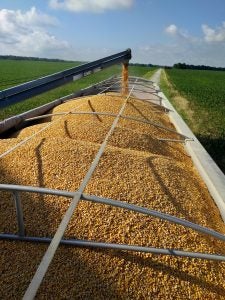Driving past our farm looks as if we just raise corn and soybeans. But there is more to it than that. A third of the farm is regular dent corn and commercial soybeans. The rest of the acres have some extra value over market price, and those extra dollars are a big help in working our way through the downturn in commodity prices.
Waxy corn
Half our corn crop is waxy corn. Waxy has a different starch content than dent corn, and different end uses as well. The premium for waxy can change, but ours has been sitting at 55 cents over market price for the last few years. For the acres we contract the buyer will accept the first 180 bushels per acre. So I’m a happy camper in my combine cab watching the yield monitor knowing that as I get closer and closer to 180 bushels, I’m making $99 per acre more than the selling price of regular field corn. If we produce more than 180 bushels, hopefully we can deliver above our contract and continue to get the premium. If they don’t need the corn we usually send the remainder to the local ethanol plant.
Popcorn
We have been raising popcorn a couple of years longer than I have been alive. I think we started in 1978. Right now popcorn is about on par for gross dollars per acre with dent corn. But there are years when the price is well above corn. We also earn a little bit of money from freight for hauling popcorn to the packaging plant. We haven’t stored popcorn for several years, but there is a payment available for storage as well. Starting in 2017 there will also be quality incentives.

Seed beans
Anymore most of the soybeans we raise are for seed. We grow seed for two companies now. One we have grown since the early 1980s, and the other we started working with just a few years ago. Seed production comes with premium prices at the time of sale. Bonuses are also earned based on the quality and cleanliness of your crop. The less other seed, foreign material, bean pods, and out of spec soybeans the seed company needs to clean from our beans, the more we can get paid. Freight also comes into play when delivering seed. We don’t always know when they’ll call for seed to be delivered, so timing is occasionally inconvenient. A few years ago we actually delivered during harvest. Normally we’ll deliver in winter.
Plots
We make space for test plots on our farm. We do two plots for seed dealers where we plant and harvest the plot. These are pretty simple. We plant the corn and record the data through our combine at harvest, and hand a USB stick over at the end. The other two plots are actually acreage we rent out. We handle the fertility and weed control, but the planting and harvest isn’t handled by us. In all cases we don’t pay for the seed, and we get to sell the grain produced. In the latter two plots, we get some rent money and don’t plant or harvest the plots. These plots don’t cover many acres, but they are profitable for sure.
A common theme among all our acres is we don’t need any special equipment. Waxy corn and popcorn are harvested with the same planter and combine we use for dent corn. The same goes for seed soybeans versus commercial soybeans. We have to take extra steps to make sure all equipment and grains bins are clean to assure the purity of those products, but the management of the value-added crops is essentially no different than just raising normal corn and beans.
These are just a few ways we’ve been able to find markets for our crops that give us a nice boost in price over standard production. Cost reduction has been an important focus for us and many others, but it’s also worth looking at increasing the value of crops grown.



